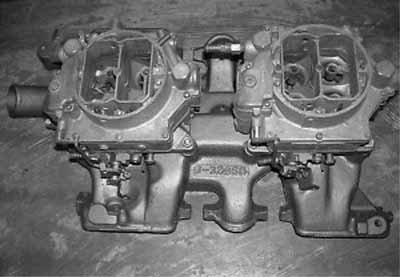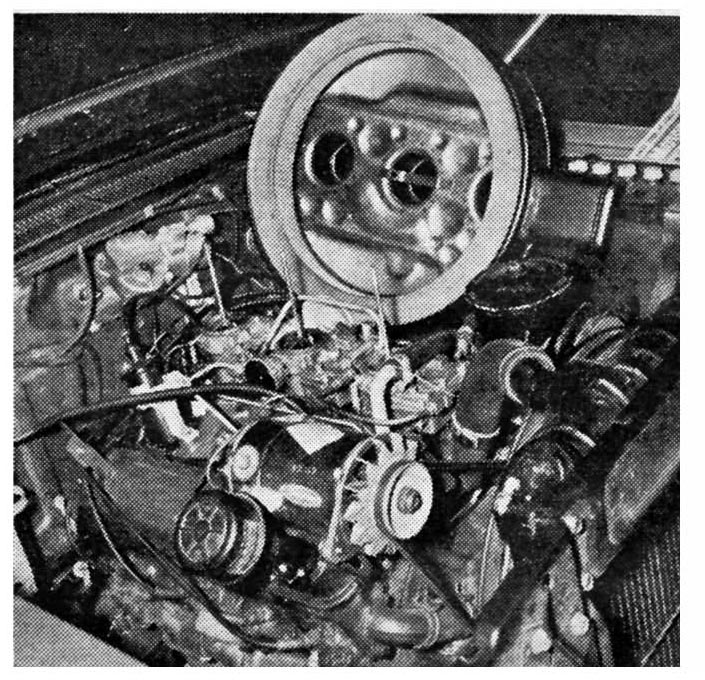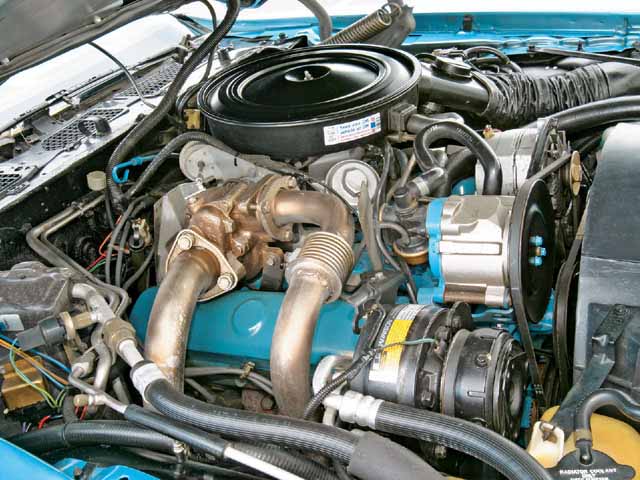Pontiac Small Journal V8s – Part One
Pontiac V8 engines are broken into two categories, small main journal and large main journal engines. All Pontiac engines have the same deck height except for the 1969 303 Trans Am engine and the short-lived 301 and 265 V8s of the early 80s.
The early 287 -370 engines used smaller main journals, with the first two utilizing 2.5″ mains and the 347 and 370 using 2.623″ mains. The 301 and 265 reverted to the original 287’s 2.5″ mains. 389 and 400 engines used the “small” (3.00″) main journals; and the 421, 428, and 455 engines used the “large” (3.25) mains. This section covers the early small journal engines and the last Pontiac engines produced, the 265 and 301 small journal V8s.
- For information on the 389 and 400 SMALL journal engines (Part II), click here.
- For information on the LARGE journal V8s, click here.
The Formative Years
Significant in early Pontiac engine development was that this engine increased in size by 100 cubic inches in only 4 years! This was unheard of in the industry where 3-year cycles were the norm. But Pontiac was chasing the mid-market performance image and had started out with a relatively small displacement V8 to begin with. Thus, they needed to increase displacement each year to catch and then move ahead of their market competition. It is a testament to the original design that the engine could grow to this size with little design changes.
Engines are listed in the order of introduction.
The 287 cu. in. V8 (1955)
The engine as introduced, was an “over square” engine with a bore of 3.75″ and a stroke of 3.25″, for a total displacement of 287.2 cu in. Compression ratio was 8.00:1, with valve diameters of 1.781″ (intake) and 1.500″ (exhaust).
It was rated 180 hp @ 4600 rpm and 264 ft lbs @ 2400 rpm with a two-barrel carburetor, 200 hp @ 4600 rpm and 278 ft lbs @ 2800 rpm with the four-barrel carburetor. The 287 was a short-lived engine size, as Pontiac realized that in the introductory year, its competition had already moved to a minimum of 320 cubic inches, and a new-sized engine would be introduced next year.
The 316.6 cu. in. V8 (1956)
For 1956 the V8 was bored out to 3.9375″, increasing displacement to 316.6 cu in. Other than increased displacement, this engine was the same cas the 1955 version. It was offered 2 and 4 barrel and 2-4 barrel versions, in 8.5, 7.9, 8.9 and 10.0:1 compression ratios, with hp from 192 to 285. The cyclinder heads were similar and still contained 1.781″ intakes and 1.500″ exhausts.
The 347 cu. in. V8 (1957)
In 1957 the V8’s stroke was increased to 3.5625″ for a displacement of 347 cu in. For the first time, Pontiac offered the soon to be famous Tri-Power, three two-barrel carburetor manifold. This unit replaced the 1956 dual-quad set-up. Power increased accordingly and there were engines in the stable with horsepower from 227 to 317 and compression ratios from from 8.5:1 to 10.25. The heads ere improved with larger valves installed; 1.88″ intakes and 1.60″ exhausts. These size valves would be used for all Pontiac V8s until the introduction of the Super Duty Engines in 1961.
Several dealer-installed “NASCAR” camshafts were offered that increased power to 310 hp @ 5200 rpm, 375 ft lbs @ 2800 rpm.
Fuel Injected 347s
Standard only for the Pontiac Bonneville was the newly introduced Rochester fuel injection system. It was similar, but not identical, to the Chevrolet unit. Pontiac did not release official power ratings for this engine, saying only that it had more than 300 hp. Contemporary tests suggest that it was actually somewhat inferior to the Tri-Power engines, although it did have better fuel economy. The was later engine was rated at 300 hp @ 5200 rpm, 375 ft lbs @ 2800 rpm.
Only 630 Bonnevilles were produced with fuel-injected 347 V8s.
The 370 cu. in. V8 (1958)
For 1958, the V8’s bore was increased again to 4.0625″, increasing displacement to 369.4 cu in. The engine is now called the “Tempest V-8” and would be called this through1960. The increase in displacement rsulted in increase hp and torque, with power ratings from 240 to 330 and torque ratings from 330 to 415. Compression was again up, with the base at 8.6:1 and the top engines at 10.5:1.
The fuel-injected engine was now an option on the Bonneville, with a price tag of $500 which for the day was almost 15% of the car’s base price. It was rated at 310 hp @ 4800 rpm and 400 ft lbs @ 3,000 rpm with 10.5:1 compression.
Performance engines began with the 285 hp 4 barrel engine and included the 300 hp Tri-Power, the 310 hp Fuel Injection, and two “NASCAR” engines, the 315 hp 4-barrel and the 330 HP Tri-Power.
Only about 400 of the 1958 fuel injection engines were produced before the system was quietly dropped.
From 1959 until 1976 only small and large journal engines were produced.
301 cu. in. V8 (1977-1981)
301 Naturally Aspirated
The 301 was offered from 1977 to 1981 and also installed in other GM cars during those years. The 301 had a 4.00″ bore and 3.00″ stroke for 301.6 cu in. The 301 block was based in part on designs for the “short deck” 303 cu in engine designed for the Trans Am series, it had a shorter deck than the big V8, and used thin-wall castings to reduce weight. The crankshafts were also unique in the fact that they featured only two counter weights instead of the usual five, plus lightened connecting rod journals.
This lighter weight design was less than the Chevrolet small-block V-8. Power output ranged from 135 hp to 170 hp. The heads were a completely new design featuring siamesed intake ports. The short-deck block and different intake ports also required the design of a new intake manifold. The Pontiac 301 EC (Electronic Controls) version offered in 1981 produced 155 hp and 245 ft lbs of torque.
301 Turbo
This engine was also offered in Turbocharged form in 1980 and was rated at 210 hp @ 4400 rpm and 345 ft lbs @ 2800 rpm. The 1981 301 Turbo gained the electronic controls with an O2 sensor, feedback ECM and E4ME Quadrajet providing a slight reduction in output to 205 hp and 340 ft lbs.
The 301 Turbo was unique in that it had a beefier block than the ’77-’79 301 engines (which carried on in the non turbo versions in 1980 and 1981), a very mild camshaft with .350″ lift and 250 degrees gross duration, a 60 psi oil pump to ensure adequate oil to the oil cooled Garrett TBO-305 Turbocharger It also featured a rolled fillet crankshaft, and a fully baffled oil pan.
The Turbo had a specific 800 CFM Quadrajet carburetor. This carb had extra-rich “DX” secondary metering rods and a remote vacuum source for the primary metering rod enrichment circuit to allow the Power Enrichment Vacuum Regulator (PEVR) to release the primary metering rods to move to the up position (enrichment) anytime during boosted conditions. This was to ensure there was enough fuel to cool the cast pistons. Boost was waste gate limited to 9 psi (+/- 1 psi).
A THM-350 non-lockup automatic transmission was used in 1980 and a TH-350C lockup was installed in 1981. The rear axle used 3.08 gearing. The 301 Turbo was limited to Trans Am and Formula Firebird production only.
Although it was much different than the original 1955-vintage Pontiac V-8 powerplant, the 301 has the distinction of being the last true Pontiac V-8 engine as Pontiac ceased V8 production on April 1, 1981.
265 cu. in. V8 (1980-1981)
Based on the same short-deck block as the 301, the 265 was offered in 1980 and 1981 only, and featured a smaller bore of 3.75″, but the same 3.00″ stroke of the 301 for 265.1 cu in. It produced 135 hp
When production ceased on the 265 and 301, Pontiac-specific V8 engines ceased to be. Shame on you General Motors.
Contributed by Michael Trebuchet – Edited by Bob Gerometta
Pontiac V8 Described P1 Image2
Pontiac proved that they were serious about performance with the release of the 2 4-barrel intake for the 316.6 V8, netting 285 HP!
Pontiac V8 Described P1 Image3
The now famous Tri-Power setup debuted on the 1957 347 V8. In NASCAR trim, it belted out 317 HP.
Pontiac V8 Described P1 Image4
Pontiac Fuel Injection debuted in 1957, right alongside the Chevrolet Unit. It looked appliance-likeand offered little performance gain over the Tri-Power and was quietly dropped in mid model year ’58.
Pontiac V8 Described P1 Image5
The 1958 Tripower engine sported 370 cubes and delivered 330 HP in NASCAR trim, the sneaky air cleaner only bolted down using the middle carb, making the intake look like the 4-barrel unit.
Pontiac V8 Described P1 Image6
The 301 V8 doesn’t look like much, and it didn’t run like much either., offering only a gain in toeque over the competing V6 and V8 engines. The 265 looked little different.


















